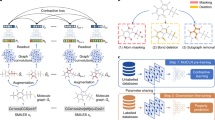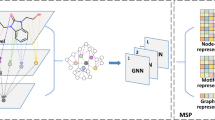Abstract
To be able to predict a molecular graph structure (W) given a 2D image of a chemical compound (U) is a challenging problem in machine learning. We are interested to learn \(f: U \rightarrow W\) where we have a fully mediating representation V such that f factors into \(U \rightarrow V \rightarrow W\). However, observing V requires detailed and expensive labels. We propose graph aligning approach that generates rich or detailed labels given normal labels W. In this paper we investigate the scenario of domain adaptation from the source domain where we have access to the expensive labels V to the target domain where only normal labels W are available. Focusing on the problem of predicting chemical compound graphs from 2D images the fully mediating layer is represented using the planar embedding of the chemical graph structure we are predicting. The empirical results show that, using only 4000 data points, we obtain up to 4x improvement of performance after domain adaptation to target domain compared to pretrained model only on the source domain. After domain adaptation, the model is even able to detect atom types that were never observed in the original source domain. Finally, on the Maybridge data set the proposed self-labeling approach reached higher performance than the current state of the art.
Access this chapter
Tax calculation will be finalised at checkout
Purchases are for personal use only
Similar content being viewed by others
Notes
- 1.
References
Fork of the official sources for the RDKit library (2020). https://github.com/biolearning-stadius/rdkit. Accessed 12 Nov 2020
Baron, R.M., Kenny, D.A.: The moderator-mediator variable distinction in social psychological research: conceptual, strategic, and statistical considerations. J. Pers. Soc. Psychol. 51(6), 1173 (1986). https://doi.org/10.1037/0022-3514.51.6.1173
Belli, D., Kipf, T.: Image-conditioned graph generation for road network extraction. arXiv preprint arXiv:1910.14388 (2019)
Bruzzone, L., Marconcini, M.: Domain adaptation problems: a DASVM classification technique and a circular validation strategy. IEEE Trans. Pattern Anal. Mach. Intell. 32(5), 770–787 (2009). https://doi.org/10.1109/TPAMI.2009.57
Dalby, A., et al.: Description of several chemical structure file formats used by computer programs developed at Molecular Design Limited. J. Chem. Inf. Comput. Sci. 32(3), 244–255 (1992). https://doi.org/10.1021/ci00007a012
Das, D., Lee, C.S.G.: Graph matching and pseudo-label guided deep unsupervised domain adaptation. In: Kůrková, V., Manolopoulos, Y., Hammer, B., Iliadis, L., Maglogiannis, I. (eds.) ICANN 2018. LNCS, vol. 11141, pp. 342–352. Springer, Cham (2018). https://doi.org/10.1007/978-3-030-01424-7_34
Filippov, I.V., Nicklaus, M.C.: Optical structure recognition software to recover chemical information: OSRA, an open source solution. J. Chem. Inf. Model. 49(3), 740–743 (2009). https://doi.org/10.1021/ci800067r
Gao, L., Song, W., Dai, J., Chen, Y.: Road extraction from high-resolution remote sensing imagery using refined deep residual convolutional neural network. Remote Sens. 11(5), 552 (2019). https://doi.org/10.3390/rs10091461
Gaulton, A., et al.: The ChEMBL database in 2017. Nucleic Acids Res. 45(D1), D945–D954 (2017). https://doi.org/10.1093/nar/gkw1074
Gold, S., Rangarajan, A.: Graduated assignment graph matching. In: Proceedings of International Conference on Neural Networks (ICNN 1996), vol. 3, pp. 1474–1479. IEEE (1996). https://doi.org/10.1109/34.491619
Han, C., Mao, J., Gan, C., Tenenbaum, J., Wu, J.: Visual concept-metaconcept learning. In: Advances in Neural Information Processing Systems, pp. 5001–5012 (2019)
Henry, C., Azimi, S.M., Merkle, N.: Road segmentation in SAR satellite images with deep fully convolutional neural networks. IEEE Geosci. Remote Sens. Lett. 15(12), 1867–1871 (2018). https://doi.org/10.1109/LGRS.2018.2864342
Kisku, D.R., Rattani, A., Grosso, E., Tistarelli, M.: Face identification by sift-based complete graph topology. In: 2007 IEEE Workshop on Automatic Identification Advanced Technologies, pp. 63–68. IEEE (2007). https://doi.org/10.1109/AUTOID.2007.380594
Kong, X., Zhang, J., Yu, P.S.: Inferring anchor links across multiple heterogeneous social networks. In: Proceedings of the 22nd ACM International Conference on Information & Knowledge Management, pp. 179–188 (2013). https://doi.org/10.1145/2505515.2505531
Kouw, W.M., Loog, M.: A review of domain adaptation without target labels. IEEE Trans. Pattern Anal. Mach. Intell. 43(3), 766–785 (2019). https://doi.org/10.1109/TPAMI.2019.2945942
Kuhn, H.W.: The Hungarian method for the assignment problem. Naval Res. Logist. Q. 2(1–2), 83–97 (1955). https://doi.org/10.1002/nav.3800020109
Locatello, F., et al.: Object-centric learning with slot attention. arXiv preprint arXiv:2006.15055 (2020)
Sadawi, N.M., Sexton, A., Sorge, V.: Chemical structure recognition: a rule based approach. In: Proceedings of SPIE, vol. 8297, p. 32, January 2012. https://doi.org/10.1117/12.912185
Mao, J., Gan, C., Kohli, P., Tenenbaum, J.B., Wu, J.: The neuro-symbolic concept learner: interpreting scenes, words, and sentences from natural supervision. arXiv preprint arXiv:1904.12584 (2019)
McDaniel, J.R., Balmuth, J.R.: Kekule: OCR-optical chemical (structure) recognition. J. Chem. Inf. Comput. Sci. 32(4), 373–378 (1992). https://doi.org/10.1021/ci00008a018
Oldenhof, M., Arany, A., Moreau, Y., Simm, J.: ChemGrapher: optical graph recognition of chemical compounds by deep learning. J. Chem. Inf. Model. 60(10), 4506–4517 (2020). https://doi.org/10.1021/acs.jcim.0c00459
Park, J., Rosania, G., Shedden, K.A., Nguyen, M., Lyu, N., Saitou, K.: Automated extraction of chemical structure information from digital raster images. Chem. Cent. J. 3 (2009). Article number: 4. https://doi.org/10.1186/1752-153X-3-4
Pearl, J.: Causal diagrams for empirical research. Biometrika 82(4), 669–688 (1995). https://doi.org/10.1093/biomet/82.4.669
Pearl, J.: Direct and indirect effects. In: Proceedings of the Seventeenth Conference on Uncertainty in Artificial Intelligence, pp. 411–420 (2001)
Pearl, J.: Causality. Cambridge University Press, Cambridge (2009)
Pearl, J., et al.: Models, Reasoning and Inference. Cambridge University Press, Cambridge (2000)
Pérez, Ó., Sánchez-Montañés, M.: A new learning strategy for classification problems with different training and test distributions. In: Sandoval, F., Prieto, A., Cabestany, J., Graña, M. (eds.) IWANN 2007. LNCS, vol. 4507, pp. 178–185. Springer, Heidelberg (2007). https://doi.org/10.1007/978-3-540-73007-1_22
Peryea, T., Katzel, D., Zhao, T., Southall, N., Nguyen, D.T.: MOLVEC: open source library for chemical structure recognition. In: Abstracts of Papers of the American Chemical Society, vol. 258. American Chemical Society, Washington, DC (2019)
Sanfeliu, A., Fu, K.S.: A distance measure between attributed relational graphs for pattern recognition. IEEE Trans. Syst. Man Cybern. 3, 353–362 (1983). https://doi.org/10.1109/TSMC.1983.6313167
Serratosa, F.: Fast computation of bipartite graph matching. Pattern Recogn. Lett. 45, 244–250 (2014). https://doi.org/10.1016/j.patrec.2014.04.015
Serratosa, F.: Computation of graph edit distance: reasoning about optimality and speed-up. Image Vis. Comput. 40, 38–48 (2015). https://doi.org/10.1016/j.imavis.2015.06.005
Serratosa, F.: Speeding up fast bipartite graph matching through a new cost matrix. Int. J. Pattern Recogn. Artif. Intell. 29(02), 1550010 (2015). https://doi.org/10.1142/S021800141550010X
Staker, J., Marshall, K., Abel, R., McQuaw, C.M.: Molecular structure extraction from documents using deep learning. J. Chem. Inf. Model. 59(3), 1017–1029 (2019). https://doi.org/10.1021/acs.jcim.8b00669. ISSN: 1549-9596
Valko, A.T., Johnson, A.P.: CLiDE Pro: the latest generation of CLiDE, a tool for optical chemical structure recognition. J. Chem. Inf. Model. 49(4), 780–787 (2009). https://doi.org/10.1021/ci800449t
Vezhnevets, A., Ferrari, V., Buhmann, J.M.: Weakly supervised structured output learning for semantic segmentation. In: 2012 IEEE Conference on Computer Vision and Pattern Recognition, pp. 845–852. IEEE (2012). https://doi.org/10.1109/CVPR.2012.6247757
Weininger, D.: SMILES, a chemical language and information system. 1. Introduction to methodology and encoding rules. J. Chem. Inf. Comput. Sci. 28(1), 31–36 (1988). https://doi.org/10.1021/ci00057a005
Willett, P., Barnard, J.M., Downs, G.M.: Chemical similarity searching. Chem. Inf. Comput. Sci. 38(6), 983–996 (1998). https://doi.org/10.1021/ci9800211
Xu, J., Schwing, A.G., Urtasun, R.: Tell me what you see and i will show you where it is. In: Proceedings of the IEEE Conference on Computer Vision and Pattern Recognition, pp. 3190–3197 (2014)
Xu, J., Schwing, A.G., Urtasun, R.: Learning to segment under various forms of weak supervision. In: Proceedings of the IEEE Conference on Computer Vision and Pattern Recognition, pp. 3781–3790 (2015)
Xu, Z., Huang, S., Zhang, Y., Tao, D.: Augmenting strong supervision using web data for fine-grained categorization. In: Proceedings of the IEEE International Conference on Computer Vision, pp. 2524–2532 (2015)
Yi, K., Wu, J., Gan, C., Torralba, A., Kohli, P., Tenenbaum, J.: Neural-symbolic VQA: disentangling reasoning from vision and language understanding. In: Advances in Neural Information Processing Systems, pp. 1031–1042 (2018)
Zhang, H., Xiao, J., Quan, L.: Supervised label transfer for semantic segmentation of street scenes. In: Daniilidis, K., Maragos, P., Paragios, N. (eds.) ECCV 2010. LNCS, vol. 6315, pp. 561–574. Springer, Heidelberg (2010). https://doi.org/10.1007/978-3-642-15555-0_41
Acknowledgments
MO, AA, YM, and JS are funded by (1) Research Council KU Leuven: C14/18/092 SymBioSys3; CELSA-HIDUCTION, (2) Innovative Medicines Initiative: MELLODDY, (3) Flemish Government (ELIXIR Belgium, IWT: PhD grants, FWO 06260) and (4) Impulsfonds AI: VR 2019 2203 DOC.0318/1QUATER Kenniscentrum Data en Maatschappij. Computational resources and services used in this work were provided by the VSC (Flemish Supercomputer Center), funded by the Research Foundation - Flanders (FWO) and the Flemish Government - department EWI. We also gratefully acknowledge the support of NVIDIA Corporation with the donation of the Titan Xp GPU used for this research.
Author information
Authors and Affiliations
Corresponding author
Editor information
Editors and Affiliations
A Appendix
A Appendix
1.1 A.1 Architecture Summary of Graph Recognition Tool
Every iteration of our method we need to train the graph recognition tool described in Oldenhof et al. [21]. This graph recognition tool is built using a combination of different convolutional neural networks. The first part is a semantic segmentation network to pixel-wise predict every atom, bond and charge type. The second part consists of three classification networks to classify every segment predicted by the semantic segmentation network. After the first step of the ChemGrapher model [21], the segmentation network (Table 3), the predicted segments are processed so that for every segment the center of mass is calculated. These centers of mass would be the atom/bond/charge candidates to be classified by the classification networks (Table 4).
1.2 A.2 Training Details for Graph Recognition Tool
Training details of the graph recognition tool for every iteration of our method are summarized in Table 5. The input images used for training of the different networks are a mix if images from source domain and upsampled rich labeled images from target domain. For pretraining of the ChemGrapher model only images from source domain were used. The training was performed using a compute node with 2 NVIDIA v100 GPUs with 32 GB of memory.
1.3 A.3 Computational Cost per Rich-Labeling Iteration
In the following Table 6 the computational cost for 1 rich-labeling iteration is summarized including all steps: (re)training, predicting and graph aligning rich-labeling.
1.4 A.4 Examples of Cases Where Graph Alignment Fails
We would like to showcase some examples where the constrained (max 2 node substitutions or max 1 edge substitution) graph alignment fails. At the same time it is important to note that our proposed domain adaptation method is an iterative method, so if a graph alignment fails in a previous iteration it could succeed in a next one when the new model makes a new graph prediction closer to the true graph.
Rights and permissions
Copyright information
© 2022 Springer Nature Switzerland AG
About this paper
Cite this paper
Oldenhof, M., Arany, A., Moreau, Y., Simm, J. (2022). Self-labeling of Fully Mediating Representations by Graph Alignment. In: Leiva, L.A., Pruski, C., Markovich, R., Najjar, A., Schommer, C. (eds) Artificial Intelligence and Machine Learning. BNAIC/Benelearn 2021. Communications in Computer and Information Science, vol 1530. Springer, Cham. https://doi.org/10.1007/978-3-030-93842-0_3
Download citation
DOI: https://doi.org/10.1007/978-3-030-93842-0_3
Published:
Publisher Name: Springer, Cham
Print ISBN: 978-3-030-93841-3
Online ISBN: 978-3-030-93842-0
eBook Packages: Computer ScienceComputer Science (R0)







